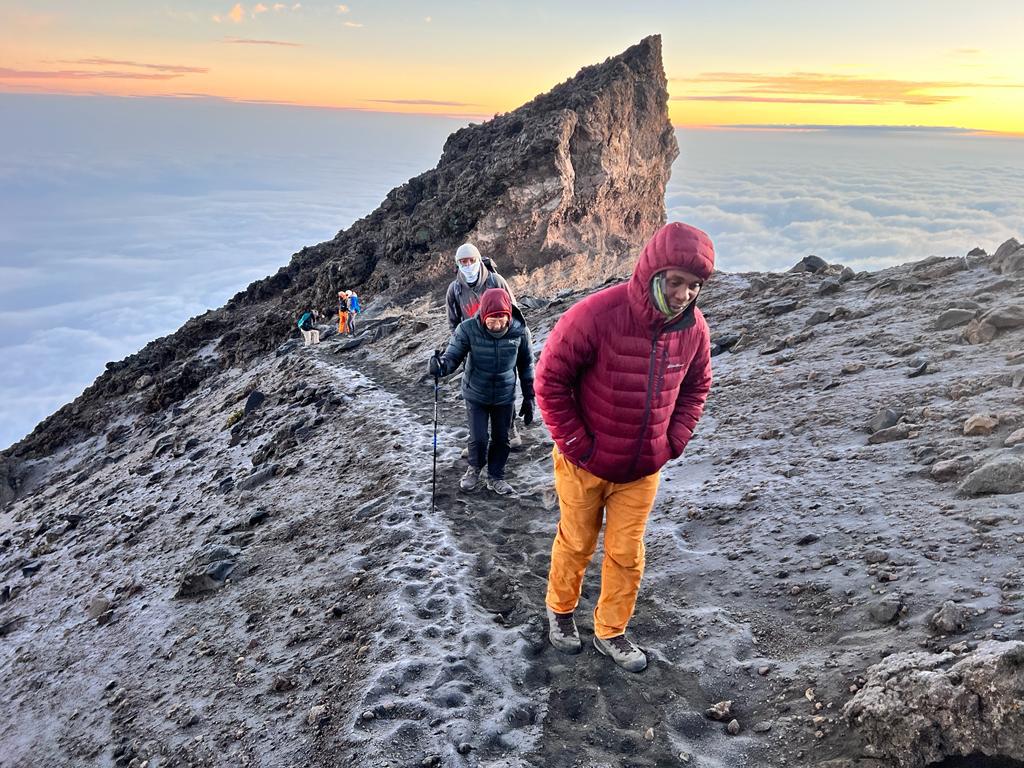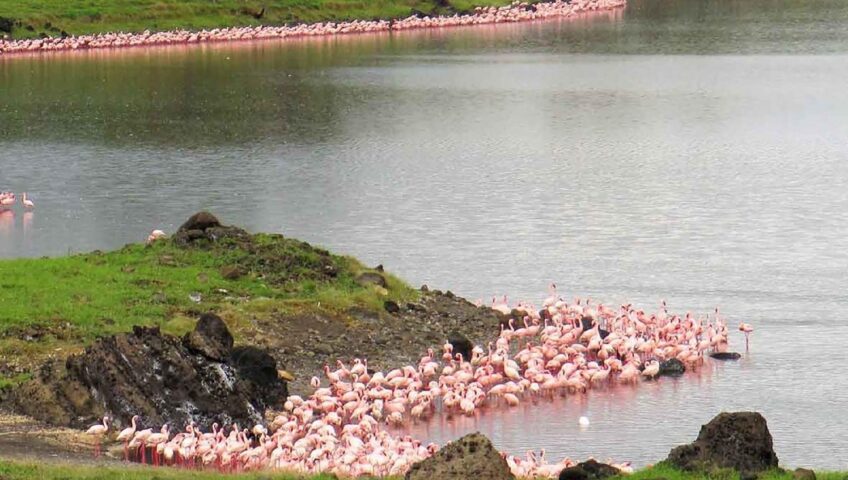One of Tanzania’s most remarkable national parks, Arusha National Park is situated in the country’s northeast, close to Arusha Town and the Kenya-Tanzania border. It is 35 kilometers by car from Arusha City, 58 kilometers from Moshi, and 35 kilometers from Kilimanjaro International Airport (KIA). The second-oldest national park in Tanzania, Arusha International Airport, is spread across an area of 552 square kilometers and features a variety of scenery in all directions. These landscapes include the funnels of the Meru crater, the Jekukumia River, and Mountain Meru’s peak in the west; the savannah-dominated Ngurdoto crater in the south-east; and the shallow, alkaline Momella lakes in the north-east.
Mount Meru, the second-highest peak in Tanzania after Mount Kilimanjaro, is part of the Arusha National Park. It is a volcanic cone that is thought to have erupted 3 million years ago. A spectacular crater called “Ngurdoto crater” is located atop this mountain, which is one of the most outstanding features in Arusha National Park. It is located at an elevation of 4,566 meters. The Ngurdoto crater, also known as the Little Ngorongoro, has a diameter of 3.2 kilometers and a depth of 300 meters. It is shaped like a basin and has extremely steep sides that are covered in dense jungle. Inhabitants of the marshy grassland at the bottom of the crater include buffalo, elephants, antelopes, baboons, leopards, monkeys, and many different species of birds.
Together with Lake Manyara National Park, Arusha National Park is the second-oldest park in Tanzania. The park owes its founding and existence to Count Teleki of Hungary, who visited the Momella region in 1876. When he first arrived, the area’s large population of hippopotamuses and black rhinos captivated him. The Trappe family also visited the area in 1907 and later built a farm there that they utilized as a cattle ranch. The farm and Ngurdoto crater were included in the territory of the park when it was formed as a national park in 1960, and in 1967 Mount Meru region was also included to the park. The Warusha locals who formerly lived in the region that now bears the name of Arusha National Park are the source of the park’s name.
In addition to its stunning scenery and natural features, Arusha National Park is home to over 400 different kinds of birds and a variety of mammal species. Arusha National Park is one of the top 6 places to visit in the world for wildlife viewing due to the high concentration of animals there. Some of the animals in the park include buffalo, zebras, warthogs, hippos, reedbucks, duikers, bush pigs, giraffes, dik-dik, leopards, elephants, wildcats, spotted hyenas, blue monkeys, and black and white colobus monkeys. The greatest places to see these creatures include the Mount Meru slopes, dark montane woods, the area around the Ngurdoto Museum, and Momella Lakes.
the number of birds Over 400 species, including forest species, migratory species that are present from November to April, woodland species, and water species along the Momella lakes’ coasts, may be found at Arusha National Park. These birds include flamingos, hammerkops, pelicans, white crested Tilt, African paradise flycatchers, grey headed bush shrikes, red-billed Oxpeckers, bronzy sunbirds, pied Avocet, black-winged stilt, African jacanas, African spoonbills, black-headed herons, Jacobin cuckoos, Levaillant’s cuckoos, crowned eagles 1690
Tourist activities in Arusha national park
Game viewing
One of the most memorable safari activities in Arusha National area is game viewing. The area is home to several kinds of large mammals that live in different vegetation types such savannah grasslands, woods, and along the Momella Lakes’ banks. During a game watching drive in an open-roofed vehicle, you can see a variety of creatures, including waterbucks, bushbucks, giraffes, leopards, elephants, buffaloes, dik-dik, zebras, and many others. There are three game viewing experiences available: morning, afternoon, and evening.
Bird watching
One of Tanzania’s most significant birding regions, Arusha National Park is home to over 400 different bird species, making birdwatching there a memorable experience. Flamingos, hammerkops, pelicans, white crested Tilts, African paradise flycatchers, grey-headed bush shrikes, red-billed Oxpeckers, bronzy sunbirds, pied Avocets, black-winged stilts, African jacanas, and African s The savannah grasslands, the shores of Momella Lake where flamingos congregate, and the slopes and base of Mount Meru all make excellent locations for bird watching.
Mountain Meru climbing
lovers of mountain climbing Mount Meru, the second-highest mountain in Tanzania and a magnificent mountain for mountain climbing adventure, is the ideal mountain for you to climb in Arusha National Park. The mountain’s Ngurdoto crater, inner wall cliffs, and steep rise from a circular base are just a few of its exquisite aesthetic features. Mountain climbing on Mount Meru is done by the Momella route, which is the only path leading to the mountain’s summit. This route begins at Momella gate on the mountain’s eastern flank and travels along the northern arm of the horsehoe crater. Utilizing the Momella route, Mount Meru may be climbed in 4 days, 3 nights.

Walking safaris
The Ujambo Wa Mbogo, also known as “the buffalo glade,” is the ideal place to conduct a walking safari in Arusha National Park. This area is dominated by marsh, bushes, and numerous streams that serve as a feeding ground for warthogs, buffaloes, and giraffes, all of which can be seen in this area. Walking safaris are a grand adventurous retreat that allow you to explore parts of the park that are not accessible by vehicle. Walking safaris are also conducted on a number of the park’s paths, including those that pass beneath Mount Meru and along the rim of Ngurdoto Crater.
Canoeing
Arusha National Park offers two sessions of canoeing on Momella Lake, each lasting about three hours and featuring beautiful scenery, wildlife, and a cool lake breeze. The morning session starts at 7:30 am, and the evening session starts at 4:00 pm. While canoeing, you can see Mount Meru clearly, as well as other wildlife including buffalo, bushbucks, giraffes, and hippos, as well as a variety of waterbirds like huge kingfishers, cattle egrets, and storks.
Horseback riding
Horseback riding takes about 5-7 hours, and while you’re on the back of the horse, you’ll see beautiful sights like Mount Meru and a variety of animals like elephants, leopards, buffaloes, and more. Horseback riding is a thrilling safari activity as well as an environmentally friendly way to tour and enjoy the adventure. A horseback riding excursion provides a wonderful opportunity to get up close to creatures like giraffes and to travel along areas that are inaccessible by car.
Accommodations in the Arusha National Park
The Arusha National Park is littered with several lodging facilities that provide travelers on safari with a place to stay. These facilities are available in luxury, midrange, and budget categories. Ngurdoto Mountain Lodge, the Africa Tulip, Arusha Serena Hotel, Resort and Spa, Ngare Sero Mountain Lodge, Momella Wildlife Lodge, Mount Meru Game Lodge, Hatari Lodge, Itikoni Seasonal Camp, and many more lodging options are available in Arusha National Park.
Accessing Arusha National Park
About 35 kilometers to the north-east of Arusha, the region’s capital, is where you’ll find Arusha National Park. Both plane and road travel are required to get to Arusha National Park, which requires a about 40-minute journey. Both private and public transportation are available by road. There are multiple daily buses that travel from Arusha city to Ngare Nanyuki village and stop at Ngongongare gate. Kilimanjaro International Airport serves as the landing point for flights to Arusha National Park; the park is 46 kilometers away from the airport.


